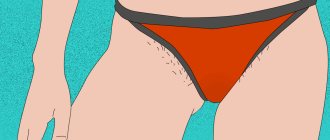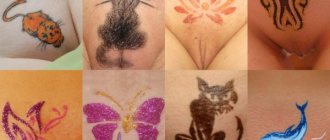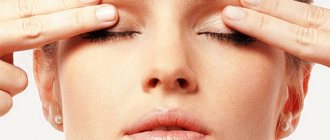Advantages and disadvantages
Photoepilation is one of the modern methods of hair removal, in which the hair follicles are exposed to light waves. Flashes of light affect melanin, as a result of which the hairs become lighter, the follicles are destroyed, and the growth of new rods stops. This procedure is very popular today and is carried out in many salons due to its following advantages:
- no damage to the skin;
- impact on a large area of hair;
- short duration of the hair removal session;
- suitable for any skin type, even the most sensitive;
- the possibility of ingrown hairs is excluded;
- absence of allergic reactions;
- rejuvenation of the skin;
- hygiene, no contact with skin;
- instant results, noticeable after the first procedure;
- long lasting results up to 5 years.
Photoepilation of the intimate area is a universal procedure suitable for men and women of all ages. But this hardware technique has a number of disadvantages:
- unpleasant, slightly painful sensations, burning sensation;
- low effectiveness for owners of gray, red hair or dark skin;
- risk of complications;
- the need for several sessions to achieve the desired result;
- high cost of the procedure.
Also, photoepilation, unlike other methods of hair removal in the bikini area, has some contraindications.
Kinds
Many representatives of the fair sex know that getting rid of unwanted hairs can be difficult. Various cosmetics and procedures come to their aid. Beauty salons and medical centers offer various types of such services, among the most common of which are:
- Mini bikini, it's classic. This type of unwanted hair removal is carried out along the line of underwear, leaving a small area of pubic hair. In other words, only that vegetation is removed that cannot be hidden under a swimsuit or panties.
- Deep bikini. Fashionistas who choose this option remove all hairs in the groin area, from the inner thigh line. This type is also called the Brazilian bikini.
- Total bikini. This procedure completely removes hair not only from the genitals, but also from all surrounding skin.
- Extra bikini. The area from which hair is removed includes the labia and intergluteal area.
To choose the appropriate hair removal option for yourself, you need to decide on the type of underwear and individual needs of the person. There is female and male hair removal. All the same types of procedures are provided for men as for women. However, among visitors to salons, the fair sex makes up the largest number of visitors.
Contraindications
Hair removal with powerful light waves is a relatively safe procedure, but there are some contraindications to its implementation:
- pregnancy, lactation period;
- damage to the skin that will be affected;
- dark or dark skin (risk of burns);
- psychological disorders;
- acute infectious diseases;
- oncological processes;
- individual intolerance to ultraviolet radiation;
- pathologies of the cardiovascular system;
- diabetes;
- gynecological diseases;
- taking certain medications;
- any dermatological diseases.
Bikini photoepilation should not be done during menstruation, after recent sunbathing or visiting a solarium, if there are piercings or tattoos in this area, as well as for girls under 16 years of age. Before you sign up for an hair removal procedure, you must consult with a specialist.
Kinds
There are several types of electrolysis - tweezer and needle. They differ in the type of electrodes and the current used.
Tweezer electrolysis is rare because it takes too much time. For this method, an electrode in the form of tweezers is used, due to which the skin is not damaged. The follicle is destroyed remotely, after which the hair is removed. With the tweezers method, removing each hair takes about two minutes. It is usually used on areas of the body with the least amount of hair and is not used to eliminate large accumulations of vegetation.
Needle electroepilator for the procedure by a cosmetologist
The most popular type of electrolysis is called needle hair removal. It involves the use of very thin (less than 0.1 millimeter in diameter) needles that act as electrodes. Today, manipulation is performed using a needle, which can be made of different materials:
- medical alloy (the most common needle, suitable for any patient who is not prone to negative reactions after its use).
- with gold coating (used in a situation where the patient experiences allergic reactions when using a medical alloy needle).
- with Teflon insulation (taken at a low pain threshold, does not provoke thermal burns).
Needle electrolysis can be used in different modes, differing in the frequency and intensity of electrical impulses. Today, there are six methods for removing unwanted hair in the armpit area:
- Galvanic electrolysis method. A direct (galvanic) current is supplied through the needle to the base of the hair. This causes sodium-based alkali to form around the root. When hydrogen bubbles appear on the skin, the specialist pulls out the electrode and removes the dead root. This procedure is not accompanied by severe pain, but its duration is longer than other methods.
- Thermolysis. This technique uses alternating high-frequency current and reduced voltage to remove hairs. Experts do not recommend using thermolysis to treat the armpits, because this method of electrolysis is the most painful and traumatic. Improper use can result in skin damage and thermal burns. To reduce the pain of the procedure, doctors use local anesthesia.
- Blend method, which includes the features of the two methods described above. The impact on the bulb is carried out using both direct and alternating current. The epilator blend allows you to regulate the frequency of electric current and voltage in real time, taking into account the characteristics of the human body.
- Sequential bland. This is a type of blend method. It is characterized by a decrease in painful sensations from manipulation, obtained by reducing the current amplitude pulse. However, the reduced intensity of exposure requires a longer procedure.
- Flash method. To some extent, it is related to the thermolysis technique, but differs from it in that it does not cause such severe pain. This implies the use of high frequency current (up to 2000 kilohertz). It does not injure the skin.
- Sequential flash. This is a more advanced flash method that allows you to remove hairs of varying thicknesses without changing the device settings. This is what distinguishes it from other electrolysis techniques. It is carried out using sinusoidal high-frequency alternating current. This allows you to increase the speed and efficiency of the procedure.
Preparation for the procedure
Photoepilation of intimate places is a hardware procedure, therefore it requires preliminary preparation, which consists of observing certain points:
- If you want to have a smooth and soft bikini area in summer, then you need to start doing hair removal in winter or early spring.
- For a month, you need to stop using an epilator or wax strips, giving preference to a razor.
- For a couple of weeks you need to stop tanning or sunbathing.
- If possible, you should stop taking antibacterial and psychotropic drugs, as well as other medications that can affect the result, 2 weeks beforehand.
- It is best to carry out photoepilation on days 5-7 or on the last day of the menstrual cycle, when the pain threshold is highest.
- At the time of hair removal, hair should be no longer than 3 mm, so you need to shave 2 days before the procedure.
- Immediately before going to the salon, you need to take a hot bath, steaming your skin.
Before going to the salon, you need to thoroughly clean the bikini area and perineum, ridding this area of any cosmetics. Proper preparation for bikini photoepilation allows you to avoid complications.
Reviews
I finally decided to have bikini photoepilation and I’ll tell you that this turned out to be the most effective area for me, the result was visible after just 3 procedures, I think a couple more sessions and I’ll forget about it. Really, I’m really happy with the result on the bikini, I can just breathe out.
sima541
https://irecommend.ru/content/dlya-tekh-kto-umeet-zhdat-0
I did a deep bikini and armpits. Personally, my armpits hardly hurt, the result was excellent the first time. A deep bikini is WILDLY painful, the pubis is tolerable, and the lips and clitoral area are hell. The result on my pubic area turned out to be good, but in the area of the lips and clitoris - not so much, since my skin there is too dark, and my hair, due to long-term sugar hair removal, has a structure that is not suitable for photos.
Medusa Gorgon
https://www.woman.ru/beauty/body/thread/4044936/
I want to share my impressions about the photoepilation procedure... Exactly 3 years have passed since the first session, I don’t regret spending my time and money on it. The result is good. Now I recommend this procedure to all my advanced friends who are tired of dealing with this problem using “grandmother’s” methods. The procedure itself is a little uncomfortable, but it’s quite possible to wait half an hour and it’s not fatal. If your pain threshold is very low, you can ask for pain relief (I realized that this is important for the bikini area). In my opinion, waxing is much more painful, and the effect does not last long. Much depends on the level of the clinic (not a beauty salon or beauty salon) and the specialist; my doctor (I emphasize a dermatologist) did a wonderful job of carrying out the procedure, attentive and tactful, and also had time to chat with her. I recommend starting photoepilation in the off-season.
MARA 25
https://otzovik.com/review_559306.html
The procedure is quite delicate; the length of the hairs must be only a few millimeters, otherwise they will melt and stick to the device. Therefore, during the first procedure, the cosmetologist herself shaved off my hair, leaving a small stubble, oh, as I remember, it’s already embarrassing. Then they gave me goggles, put some cooling gel in there, and told me to start squealing if it hurt. There was no additional pain relief. The pain is felt, BUT! From the height of electrolysis, which I am doing at the moment, I want to say that it does not hurt at all! Well, or extremely tolerant. I “oohed” to myself, but didn’t show it or make a sound. But the girl at the reception complained that she also wanted to undergo photoepilation, but was very afraid of the pain. The procedure itself takes about half an hour - an hour for a deep bikini, it's quite fast. The coverage area of the tip of the device is the size of a thin rib of a matchbox, so the process goes quickly. After the first session, I didn’t notice the result at all; it began to appear from the third procedure. My hair began to fall out before my eyes, or rather, it fell on my underwear, its growth slowed down, and towards the end I stopped shaving it altogether, because there was nothing. After completing the prescribed 8 sessions, I walked around happy for several months... until I saw new hairs!!! Yes, they were soft and light brown, the same as if I had never shaved them... But this is not permanent hair removal! Someone wrote that hair can grow back after 5 years, at least that way, but not in a few months. The thickness and length of my hair returned, I really wanted to cry, because I was sorry for the money spent.
Margarita Brusnikina
https://irecommend.ru/content/moya-istoriya-fotoepilyatsii-zony-bikini-chto-my-imeem-v-kontse-skolko-eto-stoilo-takzhe-ply
Photoepilation is very popular today due to its convenience and effectiveness. When carried out correctly, it does not injure the skin and does not cause any significant side effects. Daily use of a razor can lead to irritation on the skin, and the use of an epilator, wax or sugaring paste can cause ingrown hairs. Photoepilation will gradually and accurately destroy all unwanted vegetation without creating blemishes on the skin. At the same time, the procedure also has disadvantages, including the presence of contraindications, so before resorting to this method of removing unwanted hair, you must carefully study all its features.
- Author: woman
Rate this article:
- 5
- 4
- 3
- 2
- 1
(0 votes, average: 0 out of 5)
Share with your friends!
How is deep bikini photoepilation done?
Photoepilation of the bikini area can be simple (only pubic hair is removed) or deep (hair is excised throughout the groin and perineum).
Most often, girls choose deep bikini hair removal, since this procedure allows you to get rid of all unnecessary hair and forget about the need for shaving for a long time. This hardware technique is carried out as follows:
- First of all, the specialist sets up the device, selecting the required flash strength.
- The woman sits in a special chair, placing her legs comfortably.
- The cosmetologist and the patient wear special glasses that protect their eyes from flashes of light.
- The required area of skin is cleaned and treated with a cooling gel that reduces discomfort.
- The master moves a device manipulator over the entire bikini area, sending flashes that destroy hair follicles. Usually for a deep bikini there are about 90 light flashes.
- At the end of the procedure, a soothing moisturizer is applied to the treated area, after which the patient can go home.
The duration of the session depends on skin type, hair color and the size of the treated area and averages 20-30 minutes. The required number of photoepilation sessions to achieve a positive result is 4-10 procedures, between which there is a break of 2-4 weeks.
How many sessions will it take?
The required number of sessions depends on the characteristics of the patient’s hair and skin, the depth of the zone: on average from 4 to 12 times.
The first time, hairs that were in the growth stage at the time of the procedure are removed, and the rest are removed the next time. The intervals between operations are determined by the specialist who performs them. Typically, the interval increases after each session and the processing time decreases. Did you know?
The first hair removal creams were invented by the Egyptians. Nefertiti used a mixture of plant juice, wax and honey. For many ancient peoples, smooth skin was an indispensable condition and criterion for the beauty of the female body, and the ancient Greeks considered an overgrown female womb simply a disgrace.
What to do after?
During photoepilation, the skin is exposed to high-impulse light, so after the procedure there is a short rehabilitation period, during which the following recommendations must be followed:
- do not use cosmetics with a fatty base;
- refuse to visit open bodies of water and swimming pools;
- over the next month, avoid sunbathing, visiting solariums or saunas;
- increase water consumption in order to restore the body’s water balance;
- for the first 2 days do not use cosmetics with alcohol;
- You cannot remove remaining hairs yourself.
The skin after photoepilation is restored within 5-7 days. For the first few days, redness, burning, itching and swelling may occur in the treated area. This is a normal phenomenon, to eliminate which you need to lubricate the bikini area with a soothing cream or ointment.
Possible side effects
Based on reviews from women who have already used photoepilation, we can say that the most common undesirable effects are: swelling, redness and a feeling of minor pain.
As a rule, problems go away on their own on the second day without consequences. Less often, but still, cases were recorded when the consequences manifested themselves in a more severe form. So, we can talk about the following situations:
- Inflammation, manifested by purulent follicles. Most often they arise due to non-compliance with the rules during the rehabilitation period. The woman begins to visit ponds or swimming pools.
- Burns can appear in two cases. The specialist did not select the radiation parameters correctly or the woman has hypersensitive skin.
- Exacerbation of herpes. Occurs if the patient did not fully treat the existing infection or did not know about it at all.
- Rashes resembling acne. The effect is short-term and does not require special treatment.
- Prolonged itching or a small rash may indicate an allergic reaction to light.
- Hair growth may not stop. In the first case, gray hair begins to grow due to existing pathology associated with skin pigmentation. In the second, hypertrichosis develops (the opposite effect is formed and the hair begins to grow thicker and faster).
Some patients note the formation of scars in the deep bikini area after the procedures.
You can learn about the contraindications and consequences of laser hair removal, as well as the effectiveness of this technique, from a separate material. You can watch a video about how the non-injection mesotherapy procedure is performed and find out how many sessions are recommended to be completed here.
Well, if you are interested in the price of the RF body lifting procedure and what results to expect from this method, go here.
Consequences
The photoepilation procedure does not pose a risk to a woman’s health, but sometimes after the session some complications may appear:
- slight soreness, burning and swelling;
- redness, peeling of the skin;
- pigmentation disorder;
- minor burns;
- rashes, itching;
- tissue scarring;
- exacerbation of herpes.
If you swim in open water or pools after hair removal, purulent boils may form.
Sometimes, if the flash power is insufficient, hair begins to grow even faster after the procedure.
Further care
After hair removal using any method, irritation, red spots and other undesirable phenomena are possible. If you had the procedure done in a salon, and the specialist showed his best side, it is reasonable to ask him how best to deal with the negative consequences, but good advice can also be found on women’s forums.
Everyone agrees that the skin needs rest after hair removal, so the advice to wear loose underwear and loose clothing on the first day after hair removal seems obvious. Otherwise, each lady solves the problem in her own way - someone resorts to ordinary aftershave lotion, disinfects the skin with alcohol (even though it stings), and uses calendula ointment for red spots.
Is it possible to do the procedure at home?
Bikini photoepilation is an effective but expensive procedure that requires periodic visits to the salon. Therefore, many women are interested in whether it is possible to do such hair removal at home? This is possible with the help of a special home photoepilator, which is designed like professional equipment, but has a lower power. With such a device you can completely get rid of unnecessary vegetation, but in 10-12 sessions. The most popular models of photoepilators for home use are HoMedics DUO and Silk'n Glide Infinity.
Photos before and after
The result of deep bikini photoepilation can be seen in the before and after photos.










